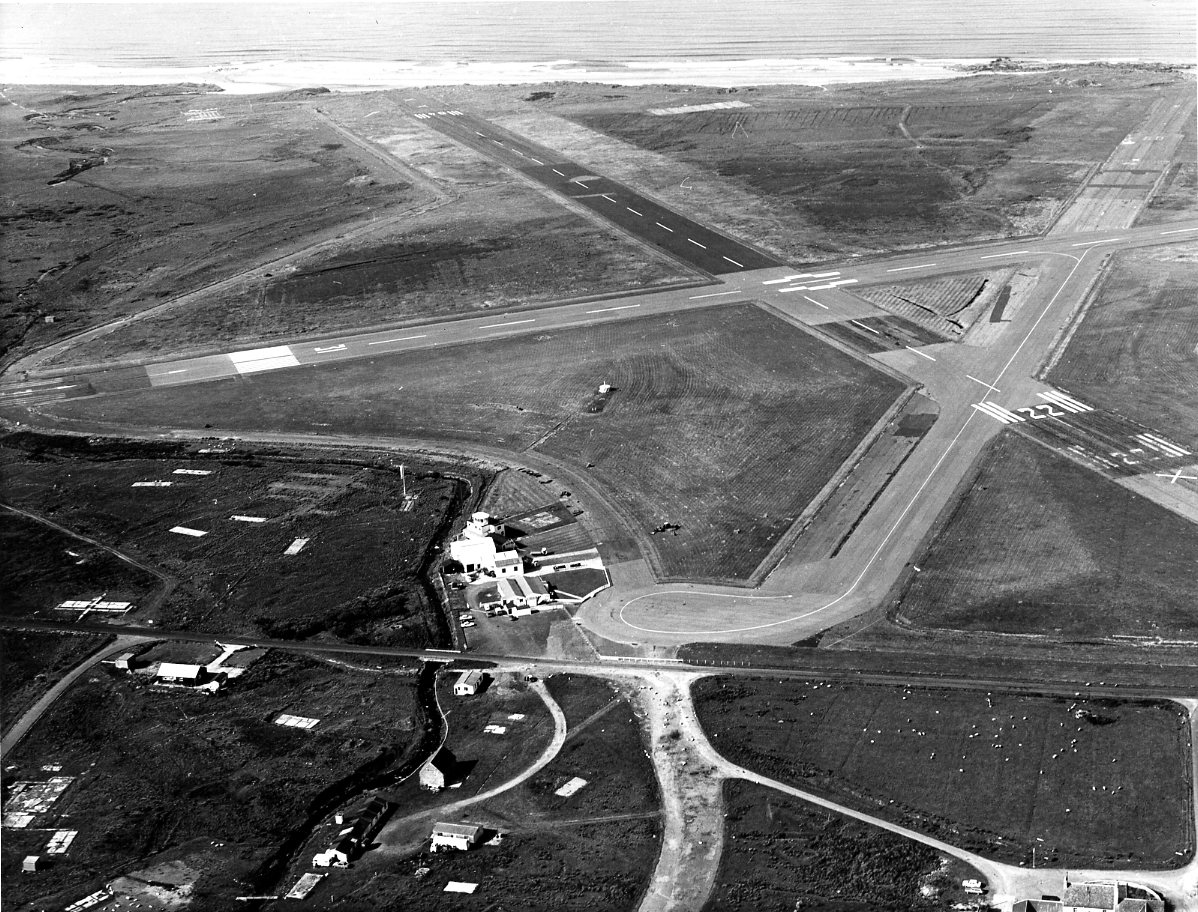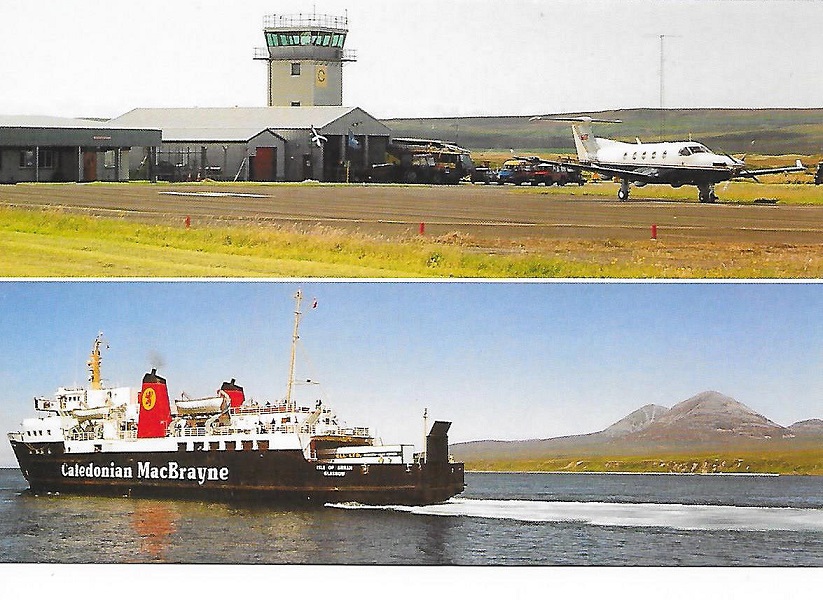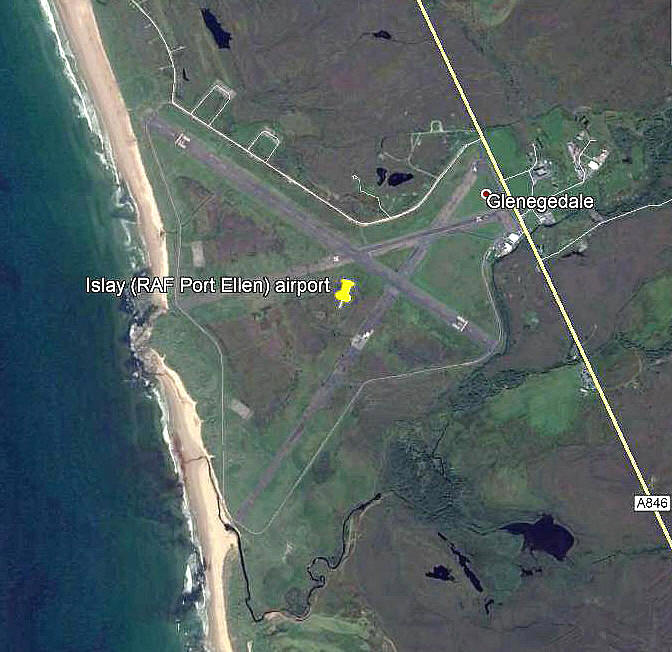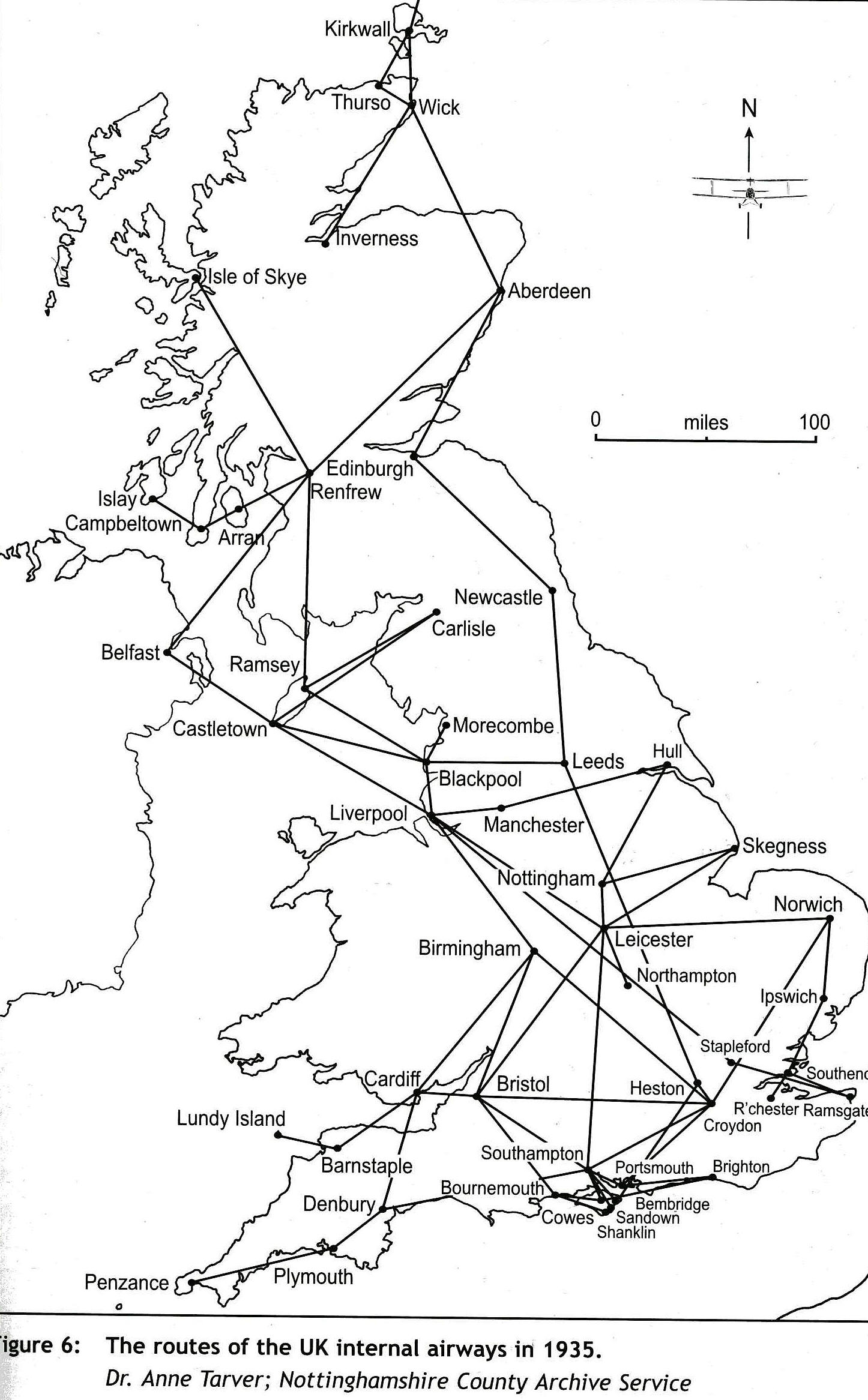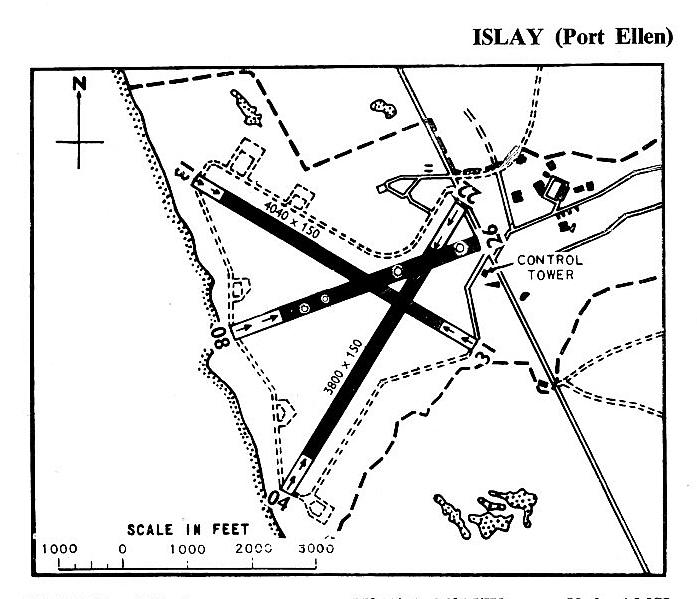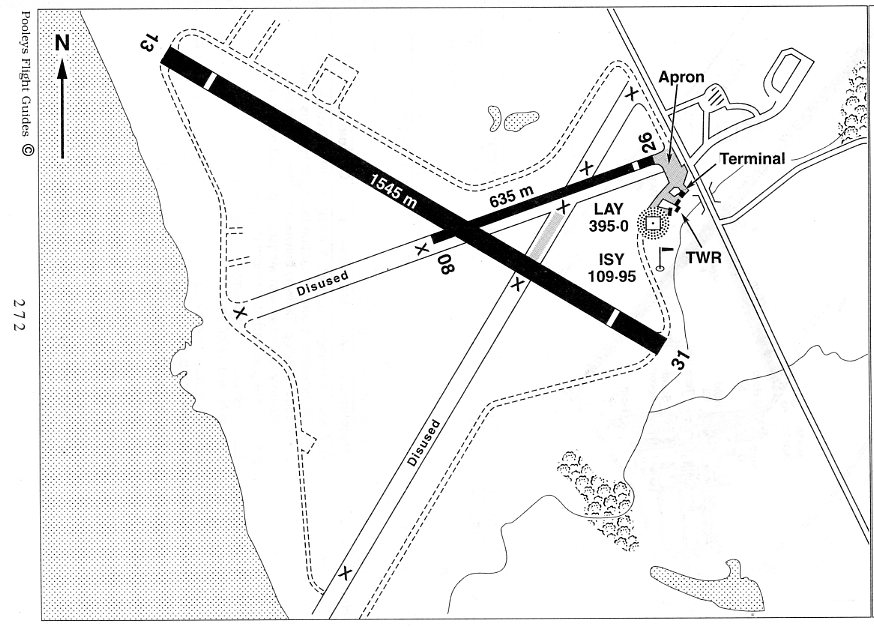Islay
ISLAY: Civil regional airport then military aerodrome reverting to regional airport
Note: The first picture is from The John Stroud Collection.
The second picture from a postcard were kindly sent by Mike Charlton who has an amazing collection. See, www.aviationpostcard.co.uk
The third picture (2016) was obtained from Google Earth ©
As far as I am aware there are still just two main ways of getting to Islay. You can either fly in or catch the Caledonian MacBrayne ferry. Interesting, I suppose, to see a Pilatus PC-12 on the apron. Presumably a private charter flight.
(Also known as GLENEGEDALE and during WW2 - PORT ELLEN, see seperate listing for WW2 details)
Operated by:
1965:Ministry of Aviation
1975: Department of Trade & Industry
1980s to 2000: Highlands & Islands Airports Ltd
Note: This map was provided by Dr Anne Tarver; Nottinghamshire County Archive Service.
British airline users: Pre 1940: Midland & Scottish Air Ferries, Northern & Scottish Airways, Western Isles Airways
Post 1945: BEA (British European Airways), Flybe - services by Loganair, Hebridean Air Services
Gliding: 1970s only?
Helipad: 1990: On apron at runway 26 threshold
Location: W of A846, 4.5nm NNW of Port Ellen
Period of operation: 1930s to present day
Note: These maps are reproduced with the kind permission of Pooleys Flight Equipment Ld. Copyright Robert Pooley 2014.
Runways: Originally ‘all-over’ grass airfield?
1965: 13/31 1231x46 hard 04/22 1158x46 hard
1990: 13/31 1545x46 hard 08/26 647x18 hard
2000: 13/31 1545x46 hard 08/26 635x18 hard
NOTES: It appears that the very first ‘recorded’ air ambulance flight in Scotland was from ISLAY to RENFREW on the 8th May 1933. The first commercial service by Midland & Scottish Air Ferries appears to have been on the 16th May 1933. They initially used DH Fox Moths, one of which was G-ACBZ and later added two DH Dragons – G-ACCZ and G-ACDL.
ALL VERY CONFUSING
I have found it all very confusing, trying to identify the site or sites on Islay (and the other Scottish islands) regularly used by the early airlines and those used only for air ambulance flights. Perhaps one explanation is that, in a case such as this island, the early airlines would try to deliver passengers to the nearest covenient known landing ground on Islay? BRIDGEND and DUICH FARM are examples, and indeed, it appears almost certain that both BRIDGEND and DUICH FARM were being used before this site was established. There were no airports as such and even regularly used Landing Grounds had only a windsock on the field let, alone a hut or tent serving as a ‘terminal’? Certainly the case at many regional ‘airports’ in England during the 1930s.
It is perhaps difficult today to imagine just how these first airlines, attempting to open up air services, coped. They often quite literally flew around the region looking for suitable landing sites – and – most of the local populations had probably never seen an aeroplane before!
THE FIRST FATAL ACCIDENT
ISLAY is also the scene of the worst air ambulance accident which occurred on the night of 28th September 1957 but this time involving a BEA Heron from RENFREW. To quote from Iain Hutchison’s excellent book Air Ambulance. “That flight ended in tragedy when BEA’s Heron G-AOFY Sir Charles Bell came down on approach to Islay’s Glenegedale Airport in appalling weather conditions. On board were Captain Paddy Calderwood, Radio Officer Hugh McGinlay and Sister Jean Kennedy. None of whom survived.”
“When word of the missing aircraft reached Glasgow’s Southern General Hospital, Matron Isobel Wares took the call. The time was 1.00am. ‘It was the most terrible night I ever remember. By the time I had dressed, they rang again to say the plane was lost with everyone on board. They wanted another nurse to fly out in a second ambulance’.” Is it just me? I find this request utterly astonishing. Three people had just lost their lives for the sake of one person,and yet they wanted three more to severely risk their lives as well.
Matron Isobel Wares, ‘How could I possibly ask anyone after what had happened? I wanted to go myself but the medical superintendent told me I was needed in the hospital to answer inquiries. He was right. The phone never stopped ringing for twenty four hours. Every available nurse volunteered. I chose Sister Isobel Thompson, a junior night sister.’ “By the time Sister Thompson arrived at the airport, the storm was so violent it was impossible for the aircraft even to take-off. Three hours later, BEA’s Flight Manager, Captain Eric Starling, finally managed to get the second Heron airborne and the small aircraft struggled over to Islay. But as they returned to the mainland Sister Thompson came to realise that everyone’s efforts had been in vain. The patient, Mrs Margaret McClugash, seriously ill with diabetes, died ten minutes before the plane touched down on the runway at Renfrew. It was the most disasterous night in the history of the air ambulance.”
There are several points to be made here. The first being that the Flight Manager, Eric Starling, was at the controls of the second Heron. The second being the utterly brave and selfless determination shown by all in those days. A third point being that BEA had originally specified their Herons for a single pilot crew, despite the duplication of flight controls – which they later modified by fitting just an airspeed indicator and altimeter to the right hand side. It seems very hard to me to imagine the mindset of the people who made these decisions; to specify an aircraft often operating in horrendous weather, capable of being fitted with full dual controls and instrumentation for two pilots, but for whom the saving of a few quid took precedence. Their ruthless disregard for the safety of both flight crew and passengers seems to me to border on criminal negligence? A charge, we now realise, which applies to much of BEA operational aspects.
MANAGERIAL DECISIONS
This didn’t get much better when BEA became part of British Airways. At one point BA decided to remove all the most experienced senior pilots from Scotland and forced them into long-haul operations. The nerdy-twerps at BA HQ obviously having no idea that flying year round in Scotland is quite probably the most demanding flying job anywhere in the world! So – the very best pilots are needed to cope I’d say. And, you need pilots who are very proactive and keen to take on the challenge.
VOLATILE WEATHER
Scotland has incredibly volatile weather, four seasons within a day being no exaggeration. Indeed, I have been forced to get out and sweep snow away from my truck, the wipers being unable to cope in a blizzard; and yet two hours later could have laid back in a sun-lounger. Although rare, similar conditions can reach south-east England, and I have flown through them, albeit to a much lesser extent, from WYCOMBE AIR PARK to REDHILL. It is rather interesting to see how snow behaves when spat out from a propeller spinning around a couple of feet in front.
OH DEAR!
On the 29th June 1994 the Prince of Wales was apparently the P.1C (Pilot in Command) of a BAe 146 landing here, presumably on runway 13/31? He really screwed this up, overshot the end and, although nobody was hurt, the aircraft was badly damaged. This raises several questions as landing a BAe 146 on such a long runway should be very easy. As I understand it, a senior Royal Air Force pilot would have been part of the flight crew, to oversee the flight, so, seeing that the landing was going seriously wrong, why didn't he take control and execute a 'go-around'?
Campbell cowan
This comment was written on: 2018-11-08 16:28:12I flew for bea/ba for 13 yrs on the hs748 in Scotland. Much of what you say regarding the competence of bea is rubbish. I knew many pilots who flew the Heron as copilots and captains and as far as I am aware the heron by the 1960sat least had a full complement of instruments on both sides of the flight deck. Bea also introduced the monitored approach which ensured a highly professional instrument let down from even new copilots as they were trained to the same instrument standards as Captains. Bea were the first airline to introduce the monitored approach, previous to this many airlines operated a one man band cockpit. So your swipe at Bea is unwarranted as Bea were one of the first to introduce highly managed and cross monitored instrument approaches.
Reply from Dick Flute:
Dear 'Campbell Cowan', Many thanks indeed for getting in contact - it is a pleasure to hear something so positive about BEA. As I am sure you can imagine, trying to compile a 'Guide' such as this, relies very heavily on information gathered from a wide variety of sources. As far as I am aware I have never been critical of BEA aircrew and ground-crew in Scotland. Quite the opposite I think you will find. However, the general opinion of BEA management is another matter altogether, and full of criticism. Therefore, so nice to hear they got something right. Best regards, Dick
We'd love to hear from you, so please scroll down to leave a comment!
Leave a comment ...
Copyright (c) UK Airfield Guide















